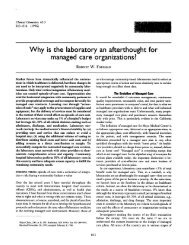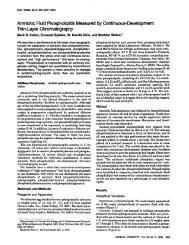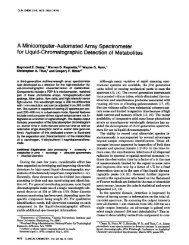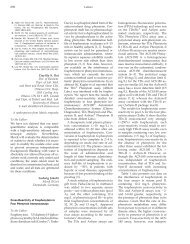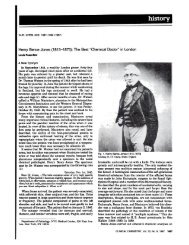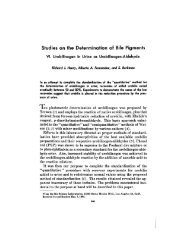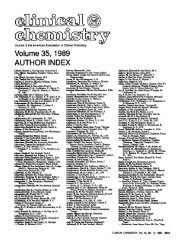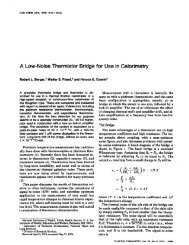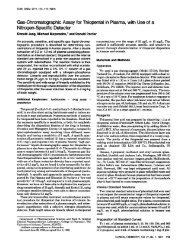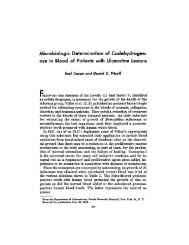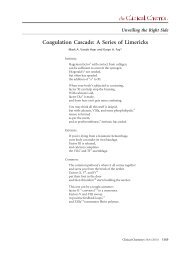Rapid Detection of K-ras Mutations in Bile by ... - Clinical Chemistry
Rapid Detection of K-ras Mutations in Bile by ... - Clinical Chemistry
Rapid Detection of K-ras Mutations in Bile by ... - Clinical Chemistry
You also want an ePaper? Increase the reach of your titles
YUMPU automatically turns print PDFs into web optimized ePapers that Google loves.
Papers <strong>in</strong> Press. First published January 12, 2004 as doi:10.1373/cl<strong>in</strong>chem.2003.024505<br />
Cl<strong>in</strong>ical <strong>Chemistry</strong> 50:3<br />
000–000 (2004) Molecular Diagnostics<br />
and Genetics<br />
<strong>Rapid</strong> <strong>Detection</strong> <strong>of</strong> K-<strong>ras</strong> <strong>Mutations</strong> <strong>in</strong> <strong>Bile</strong> <strong>by</strong><br />
Peptide Nucleic Acid-Mediated PCR Clamp<strong>in</strong>g<br />
and Melt<strong>in</strong>g Curve Analysis: Comparison<br />
with Restriction Fragment Length<br />
Polymorphism Analysis<br />
Chiung-Yu Chen, 1 Shu-Chu Shiesh, 2* and Sheu-Jen Wu 3<br />
Background: Current methods for detection <strong>of</strong> K-<strong>ras</strong><br />
gene mutations are time-consum<strong>in</strong>g. We aimed to develop<br />
a one-step PCR technique us<strong>in</strong>g fluorescent hybridization<br />
probes and compet<strong>in</strong>g peptide nucleic acid<br />
oligomers to detect K-<strong>ras</strong> mutations <strong>in</strong> bile and to<br />
compare the efficacy with restriction fragment length<br />
polymorphism (RFLP) analysis.<br />
Methods: <strong>Bile</strong> samples were obta<strong>in</strong>ed from 116 patients<br />
with biliary obstruction, <strong>in</strong>clud<strong>in</strong>g gallstone (n 64),<br />
benign biliary stricture (n 6), pancreatic cancer (n <br />
20), and cholangiocarc<strong>in</strong>oma (n 26). The DNA was<br />
extracted and subjected to K-<strong>ras</strong> mutation analysis <strong>by</strong><br />
real-time PCR and RFLP analysis. <strong>Mutations</strong> were confirmed<br />
<strong>by</strong> direct sequenc<strong>in</strong>g. The sensitivity and specificity<br />
were calculated accord<strong>in</strong>g to the cl<strong>in</strong>ical results.<br />
Results: The analysis time for real-time PCR was
2 Chen et al.: <strong>Rapid</strong> <strong>Detection</strong> <strong>of</strong> K-<strong>ras</strong> <strong>Mutations</strong> <strong>in</strong> <strong>Bile</strong><br />
<strong>in</strong> Japanese cases (13). In general, the frequencies <strong>of</strong> K-<strong>ras</strong><br />
mutations <strong>in</strong> biliary duct carc<strong>in</strong>oma were reported to be<br />
8–100% <strong>in</strong> tissue DNA, 5–30% <strong>in</strong> bile DNA (3, 4, 10), and<br />
42% <strong>in</strong> brush<strong>in</strong>g fluids (14). The po<strong>in</strong>t mutations reside<br />
ma<strong>in</strong>ly <strong>in</strong> the first two nucleotides <strong>of</strong> codon 12. Sequenc<strong>in</strong>g<br />
analysis has revealed that the s<strong>in</strong>gle-nucleotide substitutions<br />
<strong>of</strong> K-<strong>ras</strong> codon 12 are ma<strong>in</strong>ly GAT, GTT, and<br />
CGT, compared with the wild-type codon GGT (10) for<br />
patients with pancreatic cancer and GAT, GTT, and TGT/<br />
AGT/GCT for patients with cholangiocarc<strong>in</strong>oma (15).<br />
In addition to differences <strong>in</strong> the geographic etiologies<br />
and carc<strong>in</strong>ogenesis <strong>of</strong> cholangiocarc<strong>in</strong>oma, variations <strong>in</strong><br />
the sensitivities <strong>of</strong> the methods used for detection <strong>of</strong> the<br />
K-<strong>ras</strong> mutation might expla<strong>in</strong> some <strong>of</strong> the differences <strong>in</strong><br />
K-<strong>ras</strong> mutation frequencies among studies. K-<strong>ras</strong> mutations<br />
are detected ma<strong>in</strong>ly <strong>by</strong> mutation-specific oligonucleotide<br />
hybridization, PCR-restriction fragment length<br />
polymorphism (RFLP) analysis, s<strong>in</strong>gle-strand conformation<br />
polymorphism analysis, mutant allelic-specific amplification,<br />
or direct sequenc<strong>in</strong>g. These procedures <strong>in</strong>volve<br />
multiple steps and are time-consum<strong>in</strong>g; they<br />
therefore are impractical for rout<strong>in</strong>e cl<strong>in</strong>ical use. With<br />
recent <strong>in</strong>novations <strong>in</strong> molecular technology, a new highspeed<br />
thermal cycler with onl<strong>in</strong>e detection has been<br />
developed to detect N-<strong>ras</strong> gene mutations <strong>in</strong> leukemia<br />
(16). Such real-time systems <strong>of</strong>fer many advantages, <strong>in</strong>clud<strong>in</strong>g<br />
speed, reduced risk <strong>of</strong> contam<strong>in</strong>ation, and higher<br />
accuracy (17). To detect a m<strong>in</strong>imal amount <strong>of</strong> mutant <strong>in</strong><br />
cl<strong>in</strong>ical samples, peptide nucleic acid (PNA) oligomers<br />
have been used to improve the allele-specific PCR <strong>by</strong><br />
suppress<strong>in</strong>g the amplification <strong>of</strong> the background wild<br />
type (18). This PNA-mediated PCR clamp<strong>in</strong>g technique,<br />
followed <strong>by</strong> ethidium bromide sta<strong>in</strong><strong>in</strong>g (19), a PCR-RFLP<br />
step (20), or mass spectrophotometry (21), has been<br />
applied to K-<strong>ras</strong> mutations <strong>in</strong> tumor samples. Comb<strong>in</strong><strong>in</strong>g<br />
PNA-mediated PCR clamp<strong>in</strong>g and use <strong>of</strong> a real-time<br />
thermal cycler, Sotlar et al. (22) detected the c-kit po<strong>in</strong>t<br />
mutation D816V <strong>in</strong> sk<strong>in</strong> biopsy samples from patients<br />
with urticaria pigmentosa.<br />
We conducted this study to establish a one-step realtime<br />
PCR method that comb<strong>in</strong>es a compet<strong>in</strong>g PNA oligomer<br />
(clamped probe assay) with fluorescent hybridization<br />
probes and melt<strong>in</strong>g curve analysis for the detection <strong>of</strong><br />
K-<strong>ras</strong> gene codon 12 mutations <strong>in</strong> bile and to validate their<br />
cl<strong>in</strong>ical use <strong>in</strong> the differential diagnosis <strong>of</strong> biliary obstruction.<br />
Materials and Methods<br />
collection <strong>of</strong> bile<br />
Fast<strong>in</strong>g bile was obta<strong>in</strong>ed from patients with biliary<br />
obstruction via an endoscopic nasal biliary dra<strong>in</strong>age catheter<br />
or a percutaneous transhepatic biliary dra<strong>in</strong>age catheter<br />
on the day <strong>of</strong> biliary dra<strong>in</strong>age. The bile was centrifuged<br />
at 7500 rpm for 10 m<strong>in</strong>, and the pellets and<br />
supernatants were stored at 80 °C. The causes <strong>of</strong> biliary<br />
obstruction <strong>in</strong>cluded hepatolithiasis (n 17), choledocholithasis<br />
(n 47), benign biliary stricture (n 6), pancre-<br />
atic cancer (n 20), and cholangiocarc<strong>in</strong>oma (n 26).<br />
Patients were either diagnosed based on pathology as<br />
hav<strong>in</strong>g biliary or pancreatic cancer after surgery or biopsy,<br />
or <strong>by</strong> imag<strong>in</strong>g studies and a long-term follow-up<br />
that showed the progress <strong>of</strong> <strong>in</strong>dex lesions.<br />
rflp analysis <strong>of</strong> K-<strong>ras</strong> codon 12 mutations<br />
DNA was extracted from the pellet <strong>by</strong> prote<strong>in</strong>ase K<br />
treatment followed <strong>by</strong> the Qiagen DNA Isolation Kit<br />
(Qiagen). An enriched PCR-RFLP was performed for the<br />
detection <strong>of</strong> K-<strong>ras</strong> codon 12 mutations as described previously<br />
(10, 23) with m<strong>in</strong>or modifications. In brief, the PCR<br />
was conducted <strong>in</strong> a GeneAmp 9700 thermocycler (Applied<br />
Biosystems) us<strong>in</strong>g K1A (5-ACTGAATATAAACTT-<br />
GTGGTAGTTGGACCT-3) and K1B (5-TCAAAGAATG-<br />
GTCCTGGACC-3) as primers (23). The primers<br />
conta<strong>in</strong>ed a mismatch near the 3 ends (underl<strong>in</strong>ed base)<br />
to generate a BstNI site right upstream <strong>of</strong> codon 12 <strong>in</strong><br />
cases <strong>of</strong> wild type, but not <strong>in</strong> K-<strong>ras</strong> mutants. The PCR<br />
mixture conta<strong>in</strong>ed 100 ng <strong>of</strong> DNA template, 1 M each <strong>of</strong><br />
the primers, 200 M deoxynucleotide triphosphates, 1.5<br />
mM MgCl 2,and2U<strong>of</strong>Taq polyme<strong>ras</strong>e <strong>in</strong> a total volume<br />
<strong>of</strong> 50 L. The conditions for the PCR were 94 °C for 5 m<strong>in</strong>,<br />
followed <strong>by</strong> 94 °C for 1 m<strong>in</strong>, 55 °C for 90 s, and 72 °C for<br />
90 s <strong>in</strong> each cycle for 20 cycles. After PCR, 5 L <strong>of</strong> the first<br />
PCR product was digested with 2U<strong>of</strong>BstNI (Biolabs) at<br />
60 °C for 8 h. We used 1/1000 <strong>of</strong> the first digest as a<br />
template for the second PCR with 30 cycles us<strong>in</strong>g K1A<br />
and K1C (5-GCATATTAAAACAAGATTTAC-3) as<br />
primers. The second PCR product was digested with<br />
BstNI aga<strong>in</strong>. After digestion, the DNA products were<br />
separated <strong>by</strong> electrophoresis on 3% agarose gels at 100 V<br />
for 1 h and sta<strong>in</strong>ed with ethidium bromide (Sigma). To<br />
rule out PCR- and/or <strong>in</strong>complete digestion-generated<br />
artifacts, all cases with K-<strong>ras</strong> mutations or equivocal<br />
results were confirmed <strong>by</strong> repeat<strong>in</strong>g PCR-RFLP analysis<br />
with different dilutions <strong>of</strong> the first digest.<br />
clamped probe assay for analysis <strong>of</strong> K-<strong>ras</strong><br />
mutations<br />
A set <strong>of</strong> primers was chosen to amplify a specific 164-bp<br />
genomic fragment from K-<strong>ras</strong> exon 1. Hybridization<br />
probes were designed complementary to specific mutant<br />
types <strong>in</strong> K-<strong>ras</strong> codon 12; the anchor probe was 3-labeled<br />
with fluoresce<strong>in</strong>, and the sensor probe 5-labeled with<br />
LC-Red dye and 3-phosphorylated. Two different sensor<br />
probes were selected to cover the mutation region: (a)<br />
5-LC-Red 640-labeled oligonucleotide probe to b<strong>in</strong>d the<br />
K-<strong>ras</strong> GAT (G12D) mutation (i.e., the 12Asp sensor probe),<br />
and (b) 5-LC-Red 705-labeled probe to b<strong>in</strong>d the TGT<br />
(G12C) mutation <strong>of</strong> K-<strong>ras</strong> gene (12Cys sensor probe). The<br />
different dyes labeled on the probes allowed us to perform<br />
these two assays <strong>in</strong> the same run. The compet<strong>in</strong>g<br />
wild-type PNA oligomer covered codons 10–14. The<br />
antisense strand was chosen for the PNA oligomer and<br />
the detection probes because <strong>of</strong> its lower pur<strong>in</strong>e content<br />
and, therefore, more precise hybridization results (24).
The primers, probes, and the PNA oligomer were from<br />
TIB MOLBIOL. The sequences <strong>of</strong> the primers, probes, and<br />
the PNA oligomer are listed <strong>in</strong> Table 1.<br />
For amplification with the 12Asp sensor probe, we<br />
mixed the LightCycler DNA Master Hybridization Mixture<br />
(Taq polyme<strong>ras</strong>e, PCR buffer, and deoxynucleotide<br />
triphosphate mixture; Roche Diagnostics), 5 mM MgCl 2,<br />
0.3 M anchor probe, 0.15 M sensor probe, 0.15 M PNA<br />
oligomer, and 0.5 M each <strong>of</strong> primers K-<strong>ras</strong> F and K-<strong>ras</strong> R<br />
with 10 ng <strong>of</strong> genomic DNA and added water to a f<strong>in</strong>al<br />
volume <strong>of</strong> 20 L/capillary. PCR was performed with the<br />
Roche LightCycler System (Roche Diagnostics). The conditions<br />
for the 12Cys sensor probe were the same as for<br />
the 12Asp sensor probe, except that we used 50 ng <strong>of</strong><br />
genomic DNA, 1.5 M PNA oligomer, and 3 mM MgCl 2.<br />
The PCR protocol consisted <strong>of</strong> 95 °C for 10 m<strong>in</strong> for <strong>in</strong>itial<br />
denaturation, 50 cycles <strong>of</strong> 2sat95°C for denaturation,<br />
10sat70°C for PNA oligomer b<strong>in</strong>d<strong>in</strong>g, 7sat60°C for<br />
primer anneal<strong>in</strong>g and probe b<strong>in</strong>d<strong>in</strong>g, and 15 s at 72 °C for<br />
extension.<br />
controls<br />
DNA from the colon cancer cell l<strong>in</strong>e SW480, which<br />
harbors a homozygous GGT-to-GTT mutation at codon 12<br />
<strong>of</strong> K-<strong>ras</strong>, was used as positive control <strong>in</strong> each run. One<br />
negative control (DNA from colon cancer cell l<strong>in</strong>e HT29<br />
with wild-type K-<strong>ras</strong>), and a water negative control (as<br />
control for contam<strong>in</strong>ation) were processed <strong>in</strong> parallel with<br />
each batch <strong>of</strong> samples. Mutation analysis for each bile<br />
sample was performed at least twice to confirm reproducibility.<br />
dilution experiments<br />
We evaluated the sensitivities <strong>of</strong> the methods for K-<strong>ras</strong><br />
mutation detection <strong>by</strong> dilut<strong>in</strong>g cell l<strong>in</strong>e SW480 DNA,<br />
which carries a homozygous G12V mutation, or a bile<br />
DNA sample carry<strong>in</strong>g a heterozygous G12C mutation<br />
(confirmed <strong>by</strong> sequenc<strong>in</strong>g) <strong>in</strong> wild-type human bile DNA.<br />
The 1:10 mixture conta<strong>in</strong>ed 1 ng <strong>of</strong> mutant DNA and 10<br />
ng <strong>of</strong> wild-type DNA.<br />
melt<strong>in</strong>g curve analysis<br />
After amplification, melt<strong>in</strong>g analysis was performed <strong>by</strong><br />
hold<strong>in</strong>g the denaturation reaction at 95 °C for 20 s and<br />
Cl<strong>in</strong>ical <strong>Chemistry</strong> 50, No. 3, 2004 3<br />
Table 1. DNA sequences <strong>of</strong> primers, PNA oligomer, and probe for detect<strong>in</strong>g K-<strong>ras</strong> mutations.<br />
Name DNA sequence, a 5–3 Position, b nt<br />
K-<strong>ras</strong> F c<br />
AGGCCTGCTGAAAATGACTG 83–102<br />
K-<strong>ras</strong> R GGTCCTGCACCAGTAATATGCA 246–225<br />
Anchor CGTCCACAAAATGATTCTGAATTAGCTGTATCGTCAAGGCACT-Flu 186–144<br />
12Asp LC-Red 640-CCTACGCCATCAGCTCCA-P 139–122<br />
12Cys LC-Red 705-TTGCCTACGCCACAAGCTCCAA-P 142–121<br />
PNA (NH2–CONH2) CCTACGCCACCAGCTCC 139–123<br />
a LC-Red 640 and LC-Red 705 are fluorophores. The 3 end <strong>of</strong> the mutation probe was phosphorylated to prevent probe elongation <strong>by</strong> Taq polyme<strong>ras</strong>e dur<strong>in</strong>g PCR.<br />
Bold, codon 12; underl<strong>in</strong>ed, mutated base.<br />
b The base number<strong>in</strong>g is accord<strong>in</strong>g to GenBank accession no. L00045.<br />
c F, forward; R, reverse; Flu, fluoresce<strong>in</strong>; LC-Red 640, LightCycler-Red 640; P, phosphorylated; LC-Red 705, LightCycler-Red 705.<br />
hybridization at 40 °C for 20 s, followed <strong>by</strong> heat<strong>in</strong>g from<br />
40 °C to85°C at0.3°C/s with cont<strong>in</strong>uous monitor<strong>in</strong>g <strong>of</strong><br />
fluorescence at 640 nm (for LC-Red 640 <strong>in</strong> channel 2) or<br />
705 nm (for LC-Red 705 <strong>in</strong> channel 3). The change <strong>of</strong><br />
fluorescence was converted to a melt<strong>in</strong>g peak (T m)<strong>by</strong><br />
plott<strong>in</strong>g the negative derivative <strong>of</strong> the fluorescent signal<br />
correspond<strong>in</strong>g to the temperature (dF/dT) with the<br />
s<strong>of</strong>tware. The K-<strong>ras</strong> gene mutation was identified <strong>by</strong><br />
compar<strong>in</strong>g the T m <strong>of</strong> each patient’s result with that <strong>of</strong> the<br />
DNA positive control.<br />
To optimize the PCR condition, we adjusted the Mg 2 ,<br />
PNA oligomer, and DNA concentrations. Mg 2 titration<br />
experiments were done with a patient sample harbor<strong>in</strong>g<br />
the K-<strong>ras</strong> codon 12 TGT (G12C) mutant as determ<strong>in</strong>ed <strong>by</strong><br />
the clamped probe assay and direct sequenc<strong>in</strong>g. The<br />
clamped probe assay and melt<strong>in</strong>g curve analysis were<br />
performed as described above except that the MgCl 2<br />
concentration used was varied from 1 to 7 mM (total <strong>of</strong><br />
seven concentrations).<br />
dna sequenc<strong>in</strong>g<br />
The DNA from those samples that gave positive results<br />
with either <strong>by</strong> RFLP analysis or the clamped probe assay<br />
was further analyzed <strong>by</strong> direct sequenc<strong>in</strong>g. The second<br />
PCR product, visualized as a 129-bp band on the electrophoresis<br />
gel, was purified <strong>by</strong> use <strong>of</strong> a QIAquick Gel<br />
Extraction Kit (Qiagen), and concentrated (from 250 L to<br />
15 L) <strong>in</strong> a vacuum centrifuge dryer (Hetovac; VR-1).<br />
Bidirectional DNA sequenc<strong>in</strong>g <strong>of</strong> PCR products was carried<br />
out on an ABI PRISM 377 sequencer (Applied Biosystems)<br />
with a Big Dye Term<strong>in</strong>ator Cycle Sequenc<strong>in</strong>g<br />
Ready Reaction Kit.<br />
statistical analysis<br />
All data are expressed as the mean (SD). The statistical<br />
analysis was performed with SPSS 8.0 for W<strong>in</strong>dows<br />
s<strong>of</strong>tware (SPSS).<br />
Results<br />
demographic data for patients<br />
We had bile from 116 patients for analysis <strong>of</strong> K-<strong>ras</strong> codon<br />
12 mutations (Table 2). The diagnosis <strong>of</strong> cholangiocarc<strong>in</strong>oma<br />
(n 26) or pancreatic cancer (n 20) was confirmed<br />
pathologically <strong>in</strong> 34 patients (74%). Patients with-
4 Chen et al.: <strong>Rapid</strong> <strong>Detection</strong> <strong>of</strong> K-<strong>ras</strong> <strong>Mutations</strong> <strong>in</strong> <strong>Bile</strong><br />
Table 2. Demographic data for patients.<br />
Group M:F<br />
Mean (SD)<br />
age, years<br />
Mean (SD)<br />
follow-up, months<br />
Pancreatic cancer 12:8 64.1 (13.4) 8.9 (13.3)<br />
Cholangiocarc<strong>in</strong>oma 13:13 67.0 (9.5) 6.2 (7.2)<br />
Hepatolithiasis 7:10 55.8 (15.6) 18.4 (17.6) a,b<br />
Choledocholithasis 29:18 67.3 (15.1) 13.3 (13.1) b<br />
Benign biliary stricture 4:2 57.8 (17.5) 20.6 (15.4) b<br />
a P 0.05 between this group and pancreatic cancer group.<br />
b P 0.05 between this group and the cholangiocarc<strong>in</strong>oma group <strong>by</strong> one-way<br />
ANOVA.<br />
out a pathology diagnosis were diagnosed based on the<br />
severe and lethal course <strong>of</strong> the disease, which accounts for<br />
the shorter follow-up period <strong>in</strong> these patients than for<br />
patients with benign biliary obstruction. The patients who<br />
were diagnosed with benign biliary stricture <strong>in</strong>cluded<br />
those with chronic pancreatitis (n 2), pancreatic tuberculosis<br />
(n 1), papillary stenosis (n 2), and serous<br />
adenoma <strong>of</strong> the pancreas (n 1). None <strong>of</strong> the patients<br />
with gallstones or benign biliary obstructions developed<br />
biliary malignancies dur<strong>in</strong>g a follow-up period <strong>of</strong> 15.2<br />
(14.6) months.<br />
analysis <strong>of</strong> mutant and wild-type K-<strong>ras</strong> <strong>by</strong><br />
clamped probe assay<br />
Real-time PCR with the clamped probe assay accurately<br />
identified the K-<strong>ras</strong> mutation from the wild-type genome.<br />
In the absence <strong>of</strong> PNA oligomer, we observed a melt<strong>in</strong>g<br />
peak at 66.3 °C for the wild type with the 12Cys sensor<br />
probe. The addition <strong>of</strong> PNA oligomer successfully suppressed<br />
the amplification <strong>of</strong> the wild type. For the 12Cys<br />
sensor probe, Mg 2 titration experiments showed that the<br />
reaction with 3 mM MgCl 2 provided the highest melt<strong>in</strong>g<br />
peak for bile DNA with the K-<strong>ras</strong> codon 12TGT mutant<br />
(Fig. 1 <strong>in</strong> the Data Supplement that accompanies the<br />
onl<strong>in</strong>e version <strong>of</strong> this article at http://www.cl<strong>in</strong>chem.<br />
org/content/vol50/issue3/). The effects <strong>of</strong> various<br />
amounts <strong>of</strong> PNA oligomer, Mg 2 , and DNA template on<br />
the melt<strong>in</strong>g curves obta<strong>in</strong>ed with the 12Cys probe are<br />
shown <strong>in</strong> Fig. 2 <strong>in</strong> the onl<strong>in</strong>e Data Supplement. In the<br />
presence <strong>of</strong> 1.5 M PNA oligomer, 3 mM Mg 2 , and 50 ng<br />
<strong>of</strong> DNA, the clamped probe assay showed the least<br />
wild-type background and best mutant signal and was<br />
applied to the rest <strong>of</strong> the reactions. Table 3 and Figs. 3 and<br />
4 provide the results <strong>of</strong> test<strong>in</strong>g for K-<strong>ras</strong> codon 12 mutations.<br />
The melt<strong>in</strong>g curve analysis showed that the 12Cys<br />
sensor probe can detect four k<strong>in</strong>ds <strong>of</strong> K-<strong>ras</strong> codon 12<br />
mutations: GAT, GTT, AGT, and TGT mutants with mean<br />
(SD) melt<strong>in</strong>g temperatures <strong>of</strong> 65.1 (0.18), 66.5 (0.29), 67.8<br />
(0.17), and 70.6 (0.22) °C, respectively (Fig. 1 and Table 3).<br />
With the 12Asp sensor probe, we observed a melt<strong>in</strong>g peak<br />
at 62.5 °C for the wild type <strong>in</strong> the absence <strong>of</strong> PNA<br />
oligomer. The 12Asp sensor probe can detect only two<br />
k<strong>in</strong>ds <strong>of</strong> po<strong>in</strong>t mutation, however: the GTT and GAT<br />
Table 3. Melt<strong>in</strong>g temperatures <strong>of</strong> mutants <strong>by</strong> real-time PCR<br />
with PNA and codon 12 mutation-specific sensor probes.<br />
Mean (SD) T m, °C<br />
Mutant No. <strong>of</strong> cases 12Cys probe 12Asp probe<br />
G12D (GAT) 8 65.14 (0.18) 67.1 (0.40)<br />
G12C (TGT) 2 70.65 (0.22) a<br />
G12S (AGT) 1 67.8 (0.17) b<br />
a<br />
G12V (GTT) 5 66.5 (0.29) 61.9 (0.45) c<br />
a No melt<strong>in</strong>g peaks detected.<br />
b Obta<strong>in</strong>ed <strong>by</strong> repeat<strong>in</strong>g the measurement <strong>in</strong> five different runs.<br />
c One case was not detected <strong>by</strong> 12Asp probe.<br />
mutations with melt<strong>in</strong>g temperatures <strong>of</strong> 61.9 (0.45) and<br />
67.1 (0.40) °C, respectively (Fig. 2).<br />
rflp analysis <strong>of</strong> mutant and wild-type K-<strong>ras</strong><br />
Typical RFLP results are shown <strong>in</strong> Fig. 3. PCR with<br />
primers K1A and K1B gave rise to a 157-bp fragment<br />
conta<strong>in</strong><strong>in</strong>g two BstNI restriction sites if codon 12 was wild<br />
type and one BstNI site if codon 12 conta<strong>in</strong>ed a mutation<br />
<strong>in</strong> either <strong>of</strong> its first two bases. Hence, BstNI cut the<br />
amplified wild-type fragment twice to yield 29-, 114-, and<br />
14-bp fragments, but cut K-<strong>ras</strong> codon 12 mutant once to<br />
generate 143- and 14-bp fragments. When a second PCR<br />
was performed with primers K1A and K1C, the mutant<br />
K-<strong>ras</strong> fragment after amplification was 129 bp, which was<br />
no longer cut <strong>by</strong> BstNI, whereas the wild-type fragment<br />
was further cleaved <strong>by</strong> BstNI to a 100-bp fragment. If we<br />
counted those with a s<strong>in</strong>gle band <strong>of</strong> 129 bp or heterozygous<br />
bands <strong>of</strong> 129 and 100 bp as mutants, the frequency <strong>of</strong><br />
K-<strong>ras</strong> mutations <strong>in</strong> bile would be 40% (28 <strong>of</strong> 70) and 59%<br />
(27 <strong>of</strong> 46) <strong>in</strong> benign and malignant cases, respectively. To<br />
avoid possible errors from PCR or <strong>in</strong>complete digestion,<br />
mutations were counted only <strong>in</strong> those with a s<strong>in</strong>gle band<br />
<strong>of</strong> 129 bp or a predom<strong>in</strong>ant band <strong>of</strong> 129 bp (signal <strong>of</strong><br />
129-bp band greater than that <strong>of</strong> 100-bp band) on the<br />
second PCR product after digestion.<br />
comparison <strong>of</strong> different methods for<br />
detect<strong>in</strong>g K-<strong>ras</strong> mutations<br />
The clamped probe assay detected K-<strong>ras</strong> codon 12 mutants<br />
with<strong>in</strong> 1 h, whereas the RFLP analysis took 3 days to<br />
complete. Overall, 15 <strong>of</strong> 116 cases tested positive for a<br />
mutation <strong>in</strong> codon 12 <strong>of</strong> K-<strong>ras</strong> with the RFLP method,<br />
whereas 16 had mutations with the clamped probe assay<br />
us<strong>in</strong>g a 12Cys sensor probe and 12 had mutations with the<br />
12Asp sensor probe (Table 4). The positive samples detected<br />
<strong>by</strong> RFLP analysis or clamped probe assay were<br />
subjected to direct sequenc<strong>in</strong>g. In 17 cases, sequence<br />
results showed 15 mutations. In malignant cases, there<br />
was one K-<strong>ras</strong> mutation detected <strong>by</strong> the clamped probe<br />
assay (us<strong>in</strong>g a 12Cys or 12Asp probe) but not <strong>by</strong> RFLP<br />
analysis or sequenc<strong>in</strong>g, one detected <strong>by</strong> the clamped<br />
probe assay and sequenc<strong>in</strong>g but not <strong>by</strong> RFLP analysis, one<br />
detected <strong>by</strong> the clamped probe assay and RFLP analysis
Fig. 1. Representative melt<strong>in</strong>g curves obta<strong>in</strong>ed with the clamped probe assay with the 12Cys sensor probe.<br />
Results show GAT (G12D), GTT (G12V), AGT (G12S), and TGT (G12C) mutations at codon 12 <strong>of</strong> the K-<strong>ras</strong> gene.<br />
but not <strong>by</strong> sequenc<strong>in</strong>g, and one detected <strong>by</strong> RFLP analysis<br />
and sequenc<strong>in</strong>g but not <strong>by</strong> the clamped probe assay.<br />
We assessed the sensitivities <strong>of</strong> these methods for<br />
detection <strong>of</strong> K-<strong>ras</strong> mutations <strong>by</strong> dilution experiments<br />
us<strong>in</strong>g various amounts <strong>of</strong> homozygous G12V mutant<br />
SW480 DNA or heterozygous G12C mutant bile DNA <strong>in</strong><br />
wild-type bile DNA. In RFLP analysis, the mutation was<br />
detectable <strong>in</strong> the 1:100 mixture <strong>of</strong> SW480 and wild-type<br />
DNA and the 1:10 mixture <strong>of</strong> G12C mutant and wild-type<br />
bile DNA (Figs. 3, B and C). In direct sequenc<strong>in</strong>g <strong>of</strong><br />
concentrated PCR products, the mutation was detectable<br />
<strong>in</strong> the 1:20 mixture <strong>of</strong> SW480 and wild-type DNA and the<br />
1:10 mixture <strong>of</strong> G12C mutant and wild-type bile DNA.<br />
The clamped probe assay detected SW480 K-<strong>ras</strong> DNA<br />
mutation <strong>in</strong> a 3000-fold excess <strong>of</strong> wild-type bile DNA<br />
when we used the 12Cys sensor probe and 1000-fold<br />
when we used the 12Asp sensor probe. However, for<br />
detection <strong>of</strong> G12C mutant bile DNA, the mutation-specific<br />
Cl<strong>in</strong>ical <strong>Chemistry</strong> 50, No. 3, 2004 5<br />
melt<strong>in</strong>g peak was detected only down to a 20-fold excess<br />
<strong>of</strong> wild-type bile DNA (Fig. 4)<br />
cl<strong>in</strong>ical performance <strong>of</strong> different methods for<br />
the diagnosis <strong>of</strong> pancreaticobiliary<br />
malignancies<br />
In bile, K-<strong>ras</strong> codon 12 mutations were detected <strong>in</strong> 16 <strong>of</strong> 46<br />
(35%) patients with malignancy <strong>by</strong> the clamped probe<br />
assay us<strong>in</strong>g the 12Cys sensor probe, 12 (26%) <strong>by</strong> the assay<br />
us<strong>in</strong>g the 12Asp sensor probe, and 15 (33%) <strong>by</strong> RFLP<br />
analysis. All benign cases were wild type <strong>by</strong> these methods.<br />
Discussion<br />
<strong>Mutations</strong> <strong>in</strong> the <strong>ras</strong> oncogene are frequent <strong>in</strong> malignant<br />
pancreatic disease (10, 25, 26) and variable <strong>in</strong> cholangiocarc<strong>in</strong>oma<br />
(3, 27–29). K-<strong>ras</strong> codon 12 mutations have been<br />
detected <strong>in</strong> 80–95% <strong>of</strong> <strong>in</strong>filtrat<strong>in</strong>g pancreatic ductal carci-
6 Chen et al.: <strong>Rapid</strong> <strong>Detection</strong> <strong>of</strong> K-<strong>ras</strong> <strong>Mutations</strong> <strong>in</strong> <strong>Bile</strong><br />
Fig. 2. Representative melt<strong>in</strong>g curves obta<strong>in</strong>ed with the clamped probe assay with the 12Asp sensor probe.<br />
Curves represent GAT (G12D) and GTT (G12V) mutations at codon 12 <strong>of</strong> the K-<strong>ras</strong> gene.<br />
noma cases (30) and <strong>in</strong> 67% <strong>of</strong> cases with perihilar and<br />
50% <strong>of</strong> cases with <strong>in</strong>trahepatic cholangiocarc<strong>in</strong>oma (29).<br />
However, lower frequencies <strong>of</strong> K-<strong>ras</strong> gene mutations<br />
assessed from bile samples were found. In this study, we<br />
developed a one-step real-time PCR and detected K-<strong>ras</strong><br />
mutations <strong>in</strong> approximately one-third <strong>of</strong> patients with a<br />
malignant etiology for the biliary stenosis, whereas mutations<br />
were not present <strong>in</strong> any bile from patients with<br />
benign obstructions. The mutation frequency <strong>in</strong> bile was<br />
comparable to the frequencies reported <strong>in</strong> previous studies<br />
(3, 4, 8, 31). This low frequency may be expla<strong>in</strong>ed <strong>by</strong><br />
the scirrhous nature <strong>of</strong> cholangiocarc<strong>in</strong>oma; the extraductal<br />
growth <strong>of</strong> pancreatic cancer, which makes it difficult<br />
for the cancer cells to be exfoliated <strong>in</strong>to the bile; and/or<br />
the PCR <strong>in</strong>hibitors present <strong>in</strong> bile. Nevertheless, the high<br />
specificity <strong>of</strong> K-<strong>ras</strong> gene analysis <strong>in</strong> diagnos<strong>in</strong>g biliary<br />
malignancies rema<strong>in</strong>s valuable for cl<strong>in</strong>ical use.<br />
The ideal method for K-<strong>ras</strong> gene analysis <strong>in</strong> cl<strong>in</strong>ical<br />
practice would be rapid and accurate enough to allow for<br />
high-throughput screen<strong>in</strong>g. The results <strong>of</strong> the present<br />
study <strong>in</strong>dicate that real-time PCR us<strong>in</strong>g fluorescence<br />
hybridization probes with a PNA clamp<strong>in</strong>g reaction and<br />
melt<strong>in</strong>g curve analysis may <strong>of</strong>fer a promis<strong>in</strong>g method to<br />
accurately identify K-<strong>ras</strong> gene mutations <strong>in</strong> patients with<br />
biliary obstruction. The absence <strong>of</strong> post-PCR manipulation<br />
reduces the risk for carryover contam<strong>in</strong>ation and<br />
false-positive results. This detection procedure also elim<strong>in</strong>ates<br />
the need for the restriction enzyme digestion,<br />
electrophoresis, and sta<strong>in</strong><strong>in</strong>g steps required <strong>in</strong> the RFLP and<br />
s<strong>in</strong>gle-strand conformation polymorphism methods. Because<br />
rapid temperature changes are possible <strong>in</strong> the closed<br />
glass capillary, PCR occurs under rapid cycl<strong>in</strong>g conditions<br />
and the entire process can be completed with<strong>in</strong> 1 h. Together,<br />
these advantages make this assay feasible and promis<strong>in</strong>g<br />
for screen<strong>in</strong>g larger numbers <strong>of</strong> cl<strong>in</strong>ical samples.<br />
In this study, we found a high frequency <strong>of</strong> G-to-A<br />
transitions (n 9) and G-to-T transversions (n 7) with<strong>in</strong><br />
codon 12, which is <strong>in</strong> agreement with the literature<br />
(3, 13, 15). Us<strong>in</strong>g a mutant-specific sensor probe and<br />
melt<strong>in</strong>g curve analysis, we are able to identify different<br />
K-<strong>ras</strong> mutations. The different aff<strong>in</strong>ities between the mutant-specific<br />
sensor probe and K-<strong>ras</strong> mutations lead to
changes <strong>in</strong> DNA thermal stability, which <strong>in</strong> turn lead to<br />
different melt<strong>in</strong>g temperatures. The technique has also<br />
been applied successfully <strong>in</strong> the po<strong>in</strong>t mutation <strong>of</strong> c-kit (22)<br />
and the genotyp<strong>in</strong>g <strong>of</strong> hepatitis C virus (32). The present<br />
study demonstrates that the 12Cys sensor probe plus melt<strong>in</strong>g<br />
curve analysis can be used to identify at least four types<br />
<strong>of</strong> K-<strong>ras</strong> mutations, <strong>in</strong>clud<strong>in</strong>g the frequently encountered<br />
GAT and GTT mutants, with high specificity. This assay<br />
therefore possesses another advantage: that <strong>of</strong> elim<strong>in</strong>at<strong>in</strong>g<br />
the need for expensive direct DNA sequenc<strong>in</strong>g.<br />
The positive rate for K-<strong>ras</strong> mutations <strong>in</strong> bile from<br />
patients with pancreaticobiliary malignancies was 35%<br />
(16 <strong>of</strong> 46) <strong>by</strong> clamped probe assay with 12Cys sensor<br />
probe and 33% (15 <strong>of</strong> 46) <strong>by</strong> RFLP analysis. The positive<br />
samples were confirmed <strong>by</strong> sequenc<strong>in</strong>g, which showed<br />
mutations <strong>in</strong> 14 <strong>of</strong> 16 cases identified <strong>by</strong> the clamped<br />
probe assay. Because we concentrated the PCR product<br />
17-fold before sequenc<strong>in</strong>g, the sensitivity <strong>of</strong> direct sequenc<strong>in</strong>g<br />
was then comparable to that <strong>of</strong> the clamped<br />
probe assay, <strong>in</strong>dicat<strong>in</strong>g the superior sensitivity <strong>of</strong> the<br />
Table 4. Frequency <strong>of</strong> codon 12 K-<strong>ras</strong> mutations <strong>in</strong> bile<br />
from patients with biliary obstructions detected <strong>by</strong> RFLP<br />
analysis and clamped probe assay.<br />
Group Patient RFLP 12Asp 12Cys<br />
Pancreatic cancer 20 6 4 6<br />
Cholangiocarc<strong>in</strong>oma 26 9 8 10<br />
Hepatolithiasis 17 0 0 0<br />
Choledocholithasis 47 0 0 0<br />
Benign biliary stricture 6 0 0 0<br />
Total 116 15 12 16<br />
Cl<strong>in</strong>ical <strong>Chemistry</strong> 50, No. 3, 2004 7<br />
Clamped probe<br />
assay<br />
Fig. 3. PCR-RFLP analysis <strong>of</strong> K-<strong>ras</strong> mutations.<br />
(A), the gel on the left (mutant result) shows a s<strong>in</strong>gle 129-bp<br />
band for P2 (the second PCR product) and D2 (after enzyme<br />
digestion <strong>of</strong> P2). The gel on the right (wild-type result) shows<br />
a s<strong>in</strong>gle 129-bp band for P2 (the second PCR product) and<br />
100-bp band for D2 (after enzyme digestion <strong>of</strong> P2). (B),<br />
dilution experiment us<strong>in</strong>g mixtures <strong>of</strong> DNA from a cell l<strong>in</strong>e<br />
SW480, which harbors a homozygous K-<strong>ras</strong> codon 12 mutation<br />
(G12V), and DNA from a bile sample with wild-type K-<strong>ras</strong>.<br />
Lane pairs: 1, 1:2 mixture; 2, 1:10 mixture; 3, 1:20 mixture;<br />
4, 1:50 mixture; 5, 1:100 mixture; 6, 1:1000 mixture. The<br />
band on the left <strong>in</strong> each lane pair represent the second PCR<br />
product; the band on the right represent the result <strong>of</strong> enzyme<br />
digestion <strong>of</strong> the second PCR product. (C), dilution experiment<br />
us<strong>in</strong>g mixtures <strong>of</strong> DNA from a bile sample harbor<strong>in</strong>g a<br />
heterozygous K-<strong>ras</strong> codon 12 mutation (G12C) and DNA from<br />
a bile sample with wild-type K-<strong>ras</strong>. Lane M, DNA marker.<br />
clamped probe assay. Our study also demonstrated that<br />
the 12Cys sensor probe detected more k<strong>in</strong>ds <strong>of</strong> K-<strong>ras</strong><br />
codon 12 mutations with higher sensitivities than the<br />
12Asp sensor probe. Because most <strong>of</strong> the K-<strong>ras</strong> codon 12<br />
mutations <strong>in</strong> our study were G-to-A transitions (GAT)<br />
and G-to-T transversions (GTT), both <strong>of</strong> which were<br />
readily detected <strong>by</strong> both sensor probes, the negative<br />
predictive value was similar regardless <strong>of</strong> whether the<br />
12Cys or the 12Asp sensor probe was used. The advantage<br />
<strong>of</strong> the 12Cys sensor probe, however, may be demonstrated<br />
<strong>in</strong> other cl<strong>in</strong>ical sett<strong>in</strong>gs when larger numbers <strong>of</strong><br />
mutants other than GAT and GTT are present.<br />
The PNA oligomer used to suppress the amplification<br />
<strong>of</strong> the wild-type DNA was designed to b<strong>in</strong>d complementary<br />
sequences with higher thermal stability than DNA or<br />
RNA and cannot be extended <strong>by</strong> DNA polyme<strong>ras</strong>e (18).<br />
Use <strong>of</strong> the PNA oligomer molecule, which allowed sensitive<br />
detection <strong>of</strong> a mutation <strong>in</strong> a m<strong>in</strong>or fraction <strong>of</strong> tumor<br />
cells <strong>in</strong> bile, was therefore key to our method. Our results<br />
showed that the addition <strong>of</strong> 1.5 M PNA oligomer completely<br />
suppressed the wild-type melt<strong>in</strong>g signal <strong>in</strong> 50 ng<br />
<strong>of</strong> bile DNA and allowed detection <strong>of</strong> the mutation <strong>in</strong> a<br />
3000-fold excess <strong>of</strong> wild-type bile DNA. The ratio <strong>of</strong> PNA<br />
oligomer and target DNA we used was different from that<br />
used <strong>by</strong> Sotlar et al. (22); they used 0.75 M PNA oligomer<br />
<strong>in</strong> 100 ng <strong>of</strong> template DNA to detect c-kit mutations with a<br />
detection limit <strong>of</strong> 1:2000 (22). This may be attributable to the<br />
different types <strong>of</strong> samples and target genes used <strong>in</strong> their<br />
study and the present study. Furthermore, the specific<br />
melt<strong>in</strong>g peak for wild type <strong>in</strong> our study was similar to that<br />
for the G12V mutation; therefore, a high PNA oligomer<br />
concentration is needed to completely suppress the amplification<br />
<strong>of</strong> wild-type DNA and thus to prevent false positives.
8 Chen et al.: <strong>Rapid</strong> <strong>Detection</strong> <strong>of</strong> K-<strong>ras</strong> <strong>Mutations</strong> <strong>in</strong> <strong>Bile</strong><br />
Fig. 4. Serial dilution experiment show<strong>in</strong>g the sensitivity <strong>of</strong> the clamped probe assay.<br />
(A), DNA from cell l<strong>in</strong>e SW480, which harbors a homozygous K-<strong>ras</strong> codon 12 mutation (G12V), was diluted <strong>in</strong>to DNA from a bile sample with wild-type (WT) K-<strong>ras</strong>. (B),<br />
DNA from a bile sample harbor<strong>in</strong>g a heterozygous K-<strong>ras</strong> codon 12 mutation (G12C) was diluted <strong>in</strong>to DNA from bile with wild-type K-<strong>ras</strong>.<br />
However, <strong>in</strong>creases <strong>in</strong> the PNA oligomer concentration may<br />
lower the amplification <strong>of</strong> the mutant alleles, reduc<strong>in</strong>g the<br />
sensitivity <strong>of</strong> the method. Thus, the ratio <strong>of</strong> PNA oligomer to<br />
template DNA is critical for the detection <strong>of</strong> mutations with<br />
good specificity and sensitivity. When Sun et al. (21) used<br />
PNA oligomer and matrix-assisted laser-desorption/ionization<br />
time-<strong>of</strong>-light mass spectrometry for enrichment <strong>of</strong> K-<strong>ras</strong><br />
and p53 mutants <strong>in</strong> the presence <strong>of</strong> excess amounts <strong>of</strong><br />
wild-type DNA, the detection limit was reported to be as<br />
few as 3 mutant alleles <strong>in</strong> the presence <strong>of</strong> 10 000-fold excess<br />
<strong>of</strong> wild-type alleles. These results <strong>in</strong>dicate the potential <strong>of</strong><br />
this technique <strong>in</strong> high-throughput screen<strong>in</strong>g applications.<br />
The clamped probe assay, however, had a diagnostic<br />
sensitivity similar to that <strong>of</strong> RFLP analysis. It could only<br />
detect the mutation <strong>in</strong> a 1:20 mixture <strong>of</strong> heterozygous<br />
mutant bile DNA and wild-type bile DNA. This may be<br />
attributable to the presence <strong>of</strong> PCR <strong>in</strong>hibitors <strong>in</strong> bile<br />
samples. Iron-conta<strong>in</strong><strong>in</strong>g prote<strong>in</strong>s and their breakdown<br />
products, such as bilirub<strong>in</strong>, and bile salts have been<br />
identified as major <strong>in</strong>hibitors <strong>in</strong> PCR <strong>of</strong> blood samples,<br />
<strong>in</strong>clud<strong>in</strong>g real-time DNA amplification with the Light-<br />
Cycler Instrument (33, 34). The underly<strong>in</strong>g mechanisms<br />
may <strong>in</strong>volve the <strong>in</strong>activation <strong>of</strong> thermostable DNA polyme<strong>ras</strong>e<br />
and/or degradation <strong>of</strong> the nucleic acids. Because<br />
bile conta<strong>in</strong>s higher concentrations <strong>of</strong> bile salts and bilirub<strong>in</strong><br />
than blood samples, the different extents <strong>of</strong> <strong>in</strong>hibitory effects<br />
<strong>of</strong> these substances <strong>in</strong> RFLP analysis and the clamped probe<br />
assay may expla<strong>in</strong> the different detection limits for the<br />
SW480 cell l<strong>in</strong>e and mutant bile DNA. Although bov<strong>in</strong>e<br />
serum album<strong>in</strong> was reported to be the most efficient amplification<br />
facilitator (34), we found no improvement <strong>in</strong> the<br />
sensitivity with the addition <strong>of</strong> 4 g/L bov<strong>in</strong>e serum<br />
album<strong>in</strong> <strong>in</strong> the clamped probe assay. Further studies are<br />
needed to determ<strong>in</strong>e ways to m<strong>in</strong>imize the <strong>in</strong>hibitory<br />
effects <strong>of</strong> bile components <strong>in</strong> PCR and thus improve the<br />
detection sensitivity <strong>of</strong> the clamped probe assay.<br />
In conclusion, we present a practical method for rapid<br />
analysis <strong>of</strong> K-<strong>ras</strong> mutations <strong>in</strong> bile. Because K-<strong>ras</strong> gene<br />
mutations are frequently detected <strong>in</strong> other gastro<strong>in</strong>test<strong>in</strong>al<br />
malignancies, such as colon cancer, this method may be<br />
promis<strong>in</strong>g for the analysis <strong>of</strong> other body fluids (such as<br />
stool) as a mass-screen<strong>in</strong>g tool for gastro<strong>in</strong>test<strong>in</strong>al cancers.
We thank Hsiu-Chen Chiu and P<strong>in</strong>g-Hong Chen for<br />
excellent technical assistance. This work was supported<br />
<strong>by</strong> National Science Council grants NSC90-2320-B006-056,<br />
NSC91-2323-B006-011, and NSC92-2314-B006-044.<br />
References<br />
1. Bishop JM. Molecular themes <strong>in</strong> oncogenesis. Cell 1991;64:235–<br />
48.<br />
2. Tahey M, McCormick F. A cytoplasmic prote<strong>in</strong> stimulates normal<br />
N-<strong>ras</strong> p21 GTPase, but does not affect oncogenic mutants.<br />
Science 1987;238:542–5.<br />
3. Muller P, Ostwald C, Puschel K, Br<strong>in</strong>kmann B, Plath F, Kroger J, et<br />
al. Low frequency <strong>of</strong> p53 and <strong>ras</strong> mutations <strong>in</strong> bile <strong>of</strong> patients with<br />
hepato-biliary disease: a prospective study <strong>in</strong> more than 100<br />
patients. Eur J Cl<strong>in</strong> Invest 2001;31:240–7.<br />
4. Saur<strong>in</strong> JC, Joly-Pharaboz MO, Pernas P, Henry L, Ponchon T,<br />
Madjar JJ. <strong>Detection</strong> <strong>of</strong> K-<strong>ras</strong> po<strong>in</strong>t mutations <strong>in</strong> bile specimens for<br />
the differential diagnosis <strong>of</strong> malignant and benign biliary strictures.<br />
Gut 2000;47:357–61.<br />
5. Lee JG, Leung JW, Cotton PB, Layfield LJ, Mannon PJ. Diagnostic<br />
ultility <strong>of</strong> K-<strong>ras</strong> mutational analysis on bile obta<strong>in</strong>ed <strong>by</strong> endoscopic<br />
retrograde cholangiopancreatography. Gastro<strong>in</strong>test Endosc 1995;<br />
42:317–20.<br />
6. Uehara H, Nakaizumi A, Tatsuta M, Baba M, Takenaka A, Uedo N,<br />
et al. Diagnosis <strong>of</strong> pancreatic cancer <strong>by</strong> detect<strong>in</strong>g telome<strong>ras</strong>e<br />
activity <strong>in</strong> pancreatic juice: comparison with K-<strong>ras</strong> mutations. Am J<br />
Gastroenterol 1999;94:2513–8.<br />
7. Berthelemy P, Bouisson M, Escourrou J, Vaysse N, Rumeau JL,<br />
Pradayrol L. Identification <strong>of</strong> K-<strong>ras</strong> mutations <strong>in</strong> pancreatic juice <strong>in</strong><br />
the early diagnosis <strong>of</strong> pancreatic cancer. Ann Intern Med 1995;<br />
123:188–91.<br />
8. Iguchi H, Sugano K, Fukayama N, Ohkura H, Sadamoto K, Ohkoshi<br />
K, et al. Analysis <strong>of</strong> Ki-<strong>ras</strong> codon 12 mutations <strong>in</strong> the duodenal<br />
juice <strong>of</strong> patients with pancreatic cancer. Gastroenterology 1996;<br />
110:221–6.<br />
9. Caldas C, Hahn SA, Hruban RH, Redston MS, Yeo CJ, Kern SE.<br />
<strong>Detection</strong> <strong>of</strong> K-<strong>ras</strong> mutations <strong>in</strong> the stool <strong>of</strong> patients with pancreatic<br />
adenocarc<strong>in</strong>oma and pancreatic ductal hyperplasia. Cancer<br />
Res 1994;54:3568–73.<br />
10. Hruban RH, van Mansfeld ADM, Offenhaus GJA, van Weer<strong>in</strong>g DH,<br />
Allison DC, Goodman SN, et al. K-<strong>ras</strong> oncogene activation <strong>in</strong><br />
adenocarc<strong>in</strong>oma <strong>of</strong> the human pancreas: a study <strong>of</strong> 82 carc<strong>in</strong>omas<br />
us<strong>in</strong>g a comb<strong>in</strong>ation <strong>of</strong> mutant enriched polyme<strong>ras</strong>e cha<strong>in</strong><br />
reaction analysis and allele specific oligonucleotide hybridization.<br />
Am J Pathol 1993;143:545–54.<br />
11. Momoi H, Itoh T, Nozaki Y, Arima Y, Okabe H, Satoh S, et al.<br />
Microsatellite <strong>in</strong>stability and alternative genetic pathway <strong>in</strong> <strong>in</strong>trahepatic<br />
cholangiocarc<strong>in</strong>oma. J Hepatol 2001;35:235–44.<br />
12. Hidaka E, Yanagisawa A, Seki M, Takano K, Setoguchi T, Kato Y.<br />
High frequency <strong>of</strong> K-<strong>ras</strong> mutations <strong>in</strong> biliary duct carc<strong>in</strong>omas <strong>of</strong><br />
cases with a long common channel <strong>in</strong> the papilla <strong>of</strong> vater. Cancer<br />
Res 2000;60:522–4.<br />
13. Kubicka S, Kuhnel F, Flemm<strong>in</strong>g P, Ha<strong>in</strong> B, Kezmic N, Rudolph KL,<br />
et al. K-<strong>ras</strong> mutations <strong>in</strong> the bile <strong>of</strong> patients with primary scleros<strong>in</strong>g<br />
cholangitis. Gut 2001;48:403–8.<br />
14. Sturm PD, Rauws EA, Hruban RH, Caspers E, Ramsorekh TB,<br />
Huibregtse K, et al. Cl<strong>in</strong>ical value <strong>of</strong> K-<strong>ras</strong> codon 12 analysis and<br />
endobiliary brush cytology for the diagnosis <strong>of</strong> malignant extrahepatic<br />
bile duct stenosis. Cl<strong>in</strong> Cancer Res 1999;5:629–35.<br />
15. Boberg KM, Schrumpf E, Bergquist A, Broome U, Pares A, Remotti<br />
H, et al. Cholangiocarc<strong>in</strong>oma <strong>in</strong> primary scleros<strong>in</strong>g cholangitis:<br />
K-<strong>ras</strong> mutations and Tp53 dysfunction are implicated <strong>in</strong> the<br />
neoplastic development. J Hepatol 2000;32:374–80.<br />
Cl<strong>in</strong>ical <strong>Chemistry</strong> 50, No. 3, 2004 9<br />
16. Nakao M, Janssen JWG, Seriu T, Bartram CR. <strong>Rapid</strong> and reliable<br />
detection <strong>of</strong> N-<strong>ras</strong> mutations <strong>in</strong> acute lymphoblastic leukemia <strong>by</strong><br />
melt<strong>in</strong>g curve analysis us<strong>in</strong>g LightCycler technology. Leukemia<br />
2000;14:312–5.<br />
17. Fox CA, Parkes HC. Emerg<strong>in</strong>g homogeneous DNA-based technologies<br />
<strong>in</strong> the cl<strong>in</strong>ical laboratories. Cl<strong>in</strong> Chem 2001;47:990–1000.<br />
18. Ørum H, Nielsen PE, Egholm M, Berg RH, Burchardt O, Stanley C.<br />
S<strong>in</strong>gle base pair mutation analysis <strong>by</strong> PNA directed PCR-clamp<strong>in</strong>g.<br />
Nucleic Acids Res 1993;21:5332–6.<br />
19. Thiede C, Bayerdorffer E, Blasczyk R, Wittig B, Neubauer A. Simple<br />
and sensitive detection <strong>of</strong> mutations <strong>in</strong> the <strong>ras</strong> proto-oncogenes<br />
us<strong>in</strong>g PNA-mediated PCR clamp<strong>in</strong>g. Nucleic Acids Res 1996;24:<br />
983–4.<br />
20. Behn M, Thiede, Neubauer A, Pankow W, Schuermann M. Facilitated<br />
detection <strong>of</strong> oncogene mutations from exfoliated tissue<br />
material <strong>by</strong> a PNA-mediated “enriched PCR” protocol. J Pathol<br />
2000;190:69–75.<br />
21. Sun X, Jung K, Wu L, Sidransky D, Guo B. <strong>Detection</strong> <strong>of</strong> tumor<br />
mutations <strong>in</strong> the presence <strong>of</strong> the excess amounts <strong>of</strong> normal DNA.<br />
Nat Biotechnol 2002;20:186–9.<br />
22. Sotlar K, Escribano L, Landt O, Mohrle S, Lass U, Horny HP, et al.<br />
One-step detection <strong>of</strong> c-kit po<strong>in</strong>t mutations us<strong>in</strong>g peptide nucleic<br />
acid-mediated polyme<strong>ras</strong>e cha<strong>in</strong> reaction clamp<strong>in</strong>g and hybridization<br />
probes. Am J Pathol 2003;162:737–46.<br />
23. Su WC, Shiesh SC, Liu HS, Chen CY, Chow NH, L<strong>in</strong> XZ. Expression<br />
<strong>of</strong> oncogene products HER2/New and Ras and fibrosis-related<br />
growth factors bFGF, TGF-, and PDGF <strong>in</strong> bile from biliary malignancies<br />
and <strong>in</strong>flammatory disorders. Dig Dis Sci 2001;46:1387–92.<br />
24. Li Y, Zon G, Wilson WD. NMR and molecular model<strong>in</strong>g evidence for<br />
a G. A. mismatch base pair <strong>in</strong> a pur<strong>in</strong>e-rich DNA duplex. Proc Natl<br />
Acad Sci U S A 1991;88:26–30.<br />
25. Tada M, Omata M, Ohto M. Cl<strong>in</strong>ical application <strong>of</strong> <strong>ras</strong> gene<br />
mutation for diagnosis <strong>of</strong> pancreatic adenocarc<strong>in</strong>oma. Gastroenterology<br />
1991;100:233–8.<br />
26. Scarpa A, Capelli P, Villanueva A, Zamboni G, Lluis F, Accolla R, et<br />
al. Pancreatic cancer <strong>in</strong> Europe: Ki-<strong>ras</strong> mutation pattern shows<br />
geographical differences. Int J Cancer 1994;57:167–71.<br />
27. Tada M, Omata M, Ohto M. High <strong>in</strong>cidence <strong>of</strong> <strong>ras</strong> gene mutation <strong>in</strong><br />
<strong>in</strong>trahepatic cholangiocarc<strong>in</strong>oma. Cancer 1992;69:1115–8.<br />
28. Watanabe M, Asaka M, Tanaka J, Kurosawa M, Kasai M, Miyazaki<br />
T. Po<strong>in</strong>t mutation <strong>of</strong> K-<strong>ras</strong> gene codon 12 <strong>in</strong> biliary tract tumors.<br />
Gastroenterology 1994;107:1147–53.<br />
29. Ohashi K, Nakajima Y, Kanehiro H, Tsutsumi M, Taki J, Aomatsu<br />
Y, et al. Ki-<strong>ras</strong> mutations and p53 prote<strong>in</strong> expression <strong>in</strong> <strong>in</strong>trahepatic<br />
cholangiocarc<strong>in</strong>omas: relation to gross tumor morphology.<br />
Gastroenterology 1995;109:1612–7.<br />
30. Inoue S, Tezel E, Nakao A. Molecular diagnosis <strong>of</strong> pancreatic<br />
cancer. Hepatogastroenterology 2001;48:933–8.<br />
31. Tannapfel A, Benicke M, Katal<strong>in</strong>ic A, Uhlmann D, Kockerl<strong>in</strong>g F,<br />
Hauss J, et al. Frequency <strong>of</strong> p16 INK4A alterations and K-<strong>ras</strong><br />
mutations <strong>in</strong> <strong>in</strong>trahepatic cholangiocarc<strong>in</strong>oma <strong>of</strong> the liver. Gut<br />
2000;47:721–7.<br />
32. Bullock GC, Bruns DE, Haverstick DM. Hepatitis C genotype<br />
determ<strong>in</strong>ation <strong>by</strong> melt<strong>in</strong>g curve analysis with a s<strong>in</strong>gle set <strong>of</strong><br />
fluorescence resonance energy transfer probes. Cl<strong>in</strong> Chem 2002;<br />
48:2147–54.<br />
33. Akane A, Matsubara K, Nakamura H, Takahashi S, Kimura K.<br />
Identification <strong>of</strong> heme compound copurified with deoxyribonucleic<br />
acid (DNA) from bloodsta<strong>in</strong>s, a major <strong>in</strong>hibitor <strong>of</strong> polyme<strong>ras</strong>e cha<strong>in</strong><br />
reaction (PCR) amplification. J Forensic Sci 1994;39:362–72.<br />
34. Abu Al-Soud W, Radstrom P. Purification <strong>of</strong> characterization <strong>of</strong><br />
PCR-<strong>in</strong>hibitory components <strong>in</strong> blood cells. J Cl<strong>in</strong> Microbiol 2001;<br />
39:485–93.




